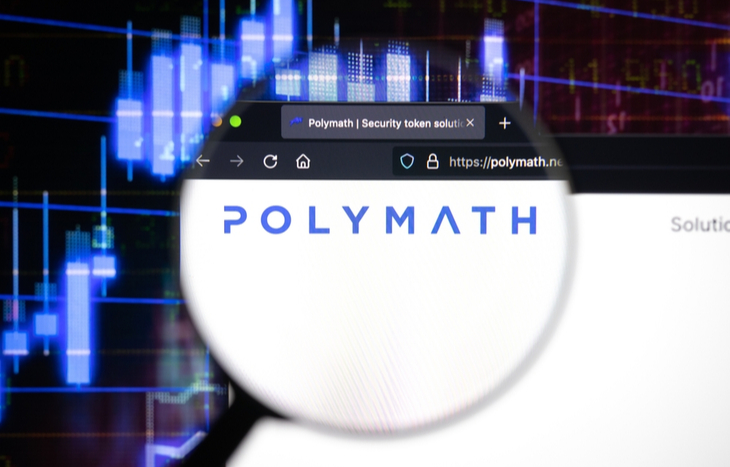Polymath Crypto: Why This Token Could Be On the Rise
Polymath crypto is benefitting from a little Binance bump. Although its valuation hasn’t changed much, trading volume for this token has spiked a bit. And that’s likely because it was just added to the popular centralized exchange binance.us.

Now keep in mind, Polymath crypto isn’t a new token. Not by a long shot. In fact, it was added to the less U.S. friendly Binance.com exchange way back in 2018. But investors here in the U.S. still can’t use that exchange, which was founded in China in 2017.
Even though Binance.com is among the leading exchanges by volume in the world, it’s faced a lot of scrutiny. It stopped accepting American users back in 2019. Since then Italian regulators banned the now Malta-based operation from operating in their country. And the U.S. has investigated Binance for tax fraud and money laundering.
But we’ve still got access to Binance.us, which allegedly operates as a separate company. But it does license software, some trademarks and its wallet tech from the original Binance. So this makes the user experience for both very similar. And that includes the relatively cheap exchange fees.
The big exception is the number of tokens listed on each. The original exchange offers access to a huge number of cryptos. Bincnace.us boasts over 80 tokens. But that figure is expected to grow. And one of its latest additions, Polymanth crypto is proof of that.
But this isn’t an exchange review. We’ve gone over Binance vs. Coinbase before. Instead let’s pick back up on Polymath and where we think it’s heading in the future.
Polymath Crypto: The Problem It’s Helping Solve
Polymath crypto was born while attempting to tokenize a private fund. The idea makes sense. Converting private equity holdings into tradable digital assets can help raise funds for new projects. Furthermore, those funds can be chopped up into very small pieces when tokenized. If a fund commits $4 million to a project, it can divide it up into 100 tokens worth $40,000 a piece. Or it can issue 4 million tokens each worth $1. It can even be fractionalized into smaller increments if the fund desires.
This opens up room for all sorts of investors. A token worth $1 is going to be accessed by more investors. However, if the private fund wants to target the interest of institutional investors, it might go with a higher token cost.
This might sound commonplace now, but it wasn’t always. Not long ago, blockchain technology was inadequate at meeting regulatory requirements posed by capital markets. This kept most private funds out of the crypto space. But that’s no longer the case.
The founders of Polymath used their capital to build Polymesh. This is touted as being an institutional-grade blockchain. One that’s built specifically for regulated assets. While there is still an emphasis on confidentiality, it also offers a clear mechanism for reporting and auditing. This is because Polymesh was developed with a focus on compliance. And make no bones about it, this would not exist without the creation of Polymath crypto.
But herein lies the conundrum. The team behind Polymath crypto discovered blockchains’ shortcomings though launching an Ethereum-based token. It helped to raise funds for a bigger project. But what’s that mean going forward?
Polymesh > Polymath?
Polymesh officially launched in October 2021. And that created a slight rise in value of Polymath crypto. But that rise was short lived. To be fair, its fall in price was about in line with the rest of the crypto markets. November 2021 wasn’t pretty for any crypto investors. And while other coins are likely to bounce back to highs in the long run, it seems less likely for Polymath.
The development team behind the token has been fueled by Polymath crypto. And projects by Polymath Token Studio helped launch more than 200 tokens using its Ethereum-based solution. Its dev team has proven very important to the crypto community. However, the token that started it all will be less valuable to the team in the near future. But that shouldn’t be cause for concern.
With the release of the Polymesh Mainnet, it’s possible to trade Polymath for POLYX on a 1:1 basis. This is noteworthy because POLYX will be the native protocol token of Polymesh. But Polymath crypto investors can sit tight. That’s because all Polymath tokens currently trading on Ethereum will be upgraded to POLYX.
So Polymesh isn’t going anywhere without Polymath. Err, PolymathX, we suppose. And that’s reason enough for investors to breathe a sigh of relief. It’s also reason for them to take notice. At less than $0.50 a token, Polymath is trading well below its all-time high.
The Bottom Line on Polymath Crypto
The uplisting to the Binance.us exchange was good news for Polymath crypto. But for a project of this scale, that’s not likely to be a major catalyst. However, when Polymesh fully switches away from being an Ethereum-based token to a coin on its own blockchain… Well that could be big news.
For the time being, Polymath crypto makes for a very intriguing investment opportunity. Its potential is huge. But hey, so was Theranos. But Polymath Token Studio actually has a worthwhile track record. (We’re not actually comparing Polymath to Theranos – no need to call your lawyers, guys.)
So big things are certainly possible for Polymath crypto. And it could help usher in a new level of investment firm dollars. That could lead to increased valuations all around the crypto markets. Mo’ money doesn’t always mean mo’ problems. Especially for long-term holders. In fact, if you’d like to calculate your crypto gains over the years, we suggest you try out our crypto calculator. It can also help you calculate potential future earnings as well.





